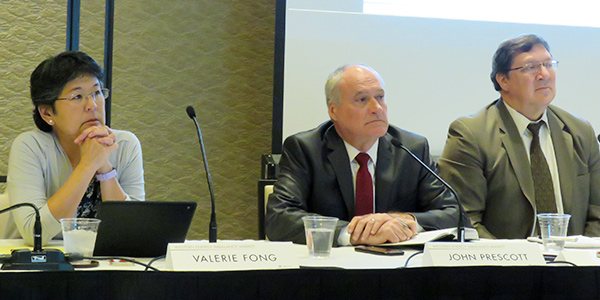By Hudson Sangree
The Governing Body of CAISO’s Western Energy Imbalance Market filled the second of two unexpected vacancies Wednesday, selecting Robert Kondziolka, who recently retired after four decades with Arizona’s Salt River Project.
Kondziolka fills a seat on the five-member board left vacant when Travis Kavulla — a former member of the Montana Public Service Commission and energy director at R Street Institute, a D.C.-based think-tank — announced in August he had to resign from the Governing Body after accepting a job with a market participant. (See EIM Governing Body Gains Member, Loses Another.)
Kavulla joined NRG Energy as vice president for regulatory affairs in September. His three-year term on the EIM Governing Body had 22 months remaining.
Kondziolka will fill out the remainder of that term, starting Feb. 1 and extending through June 30, 2021.
At SRP, Kondziolka held a half-dozen management positions, including director of transmission line design, construction and maintenance, and director of transmission and generation operations. At the time of his retirement he was a management consultant for grid resilience and security.
“Welcome, Rob. We look forward to seeing you soon,” Chair Carl Linvill said at the Governing Body’s meeting at CAISO headquarters in Folsom, Calif.
Kondziolka did not address the meeting.
Randy Howard, general manager of the Northern California Power Agency, served on the nominating committee that selected Kondziolka and presented its recommendation to the four current Governing Body members.
“We had a great set of candidates,” Howard said by phone. He explained that the committee came up with a short list from those who applied for the position or were identified by a search firm. The eight committee members had some trouble reaching a consensus but ultimately settled unanimously on Kondziolka, he said.
The committee said in a memo that it “believes Mr. Kondziolka would ensure the EIM Governing Body’s overall composition continues to reflect appropriate independence requirements and a diversity of experience, expertise and geography, as well as the continued effectiveness of the EIM Governing Body.”
The nominating committee included representatives from eight constituencies — EIM entities, transmission owners, public utilities, state regulators and the CAISO Board of Governors. John Prescott, vice chair of the Governing Body, also served on the committee, calling the nomination process “robust.”
Governing Body members Valerie Fong thanked the committee, saying, “I know these things take a lot of time, and I know that the nominating committee doesn’t take its responsibility lightly.”
The independence and geographic composition of the Governing Body, with representatives from Western states other than California, has been a main concern among participants in the continually growing EIM, which has become the major interstate trading market in the Western Interconnection.
Many from the interior West are wary of taking direction from Californians, but that hasn’t stopped the EIM’s growth. Three Colorado utilities recently announced they would join, as the EIM said its benefits to members had exceeded $800 million in the five years since its inception. (See EIM Lands Xcel, 3 Other Colo. Utilities.)
SPP is hoping to compete with the EIM with its Western Energy Imbalance Service but so far has gained little traction.
The EIM allows participants to trade wholesale electricity in real time across state borders. CAISO is considering expanding it to a day-ahead market.
Another unexpected vacancy on the Governing Body was filled in August, when the remaining three members picked Anita Decker as a colleague.
Decker, a Pacific Northwest industry veteran, filled the seat left vacant in April when Kristine Schmidt, the Governing Body’s inaugural chair, left to join the board of embattled PG&E Corp. (See PG&E Departure Leaves EIM Vacancy.)





